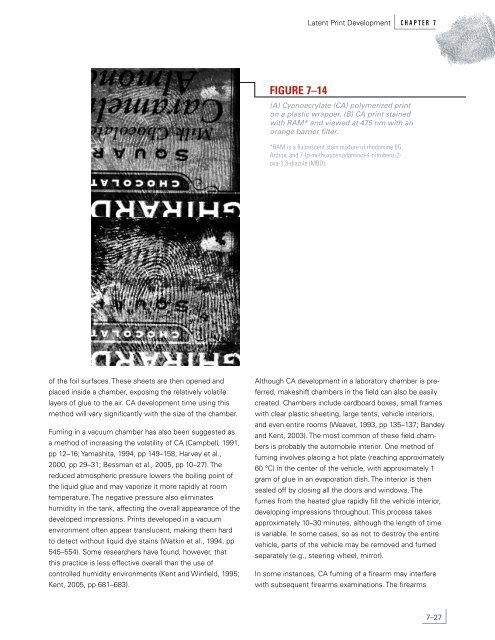Latent Print Development - National Criminal Justice Reference ...
Latent Print Development - National Criminal Justice Reference ...
Latent Print Development - National Criminal Justice Reference ...
Create successful ePaper yourself
Turn your PDF publications into a flip-book with our unique Google optimized e-Paper software.
of the foil surfaces. These sheets are then opened and<br />
placed inside a chamber, exposing the relatively volatile<br />
layers of glue to the air. CA development time using this<br />
method will vary significantly with the size of the chamber.<br />
Fuming in a vacuum chamber has also been suggested as<br />
a method of increasing the volatility of CA (Campbell, 1991,<br />
pp 12–16; Yamashita, 1994, pp 149–158; Harvey et al.,<br />
2000, pp 29–31; Bessman et al., 2005, pp 10–27). The<br />
reduced atmospheric pressure lowers the boiling point of<br />
the liquid glue and may vaporize it more rapidly at room<br />
temperature. The negative pressure also eliminates<br />
humidity in the tank, affecting the overall appearance of the<br />
developed impressions. <strong>Print</strong>s developed in a vacuum<br />
environment often appear translucent, making them hard<br />
to detect without liquid dye stains (Watkin et al., 1994, pp<br />
545–554). Some researchers have found, however, that<br />
this practice is less effective overall than the use of<br />
controlled humidity environments (Kent and Winfield, 1995;<br />
Kent, 2005, pp 681–683).<br />
FIGURE 7–14<br />
<strong>Latent</strong> <strong>Print</strong> <strong>Development</strong> C H A P T E R 7<br />
(A) Cyanoacrylate (CA) polymerized print<br />
on a plastic wrapper. (B) CA print stained<br />
with RAM* and viewed at 475 nm with an<br />
orange barrier filter.<br />
*RAM is a fluorescent stain mixture of rhodamine 6G,<br />
Ardrox, and 7-(p-methoxybenzylamino)-4-nitrobenz-2oxa-1,3-diazole<br />
(MBD).<br />
Although CA development in a laboratory chamber is preferred,<br />
makeshift chambers in the field can also be easily<br />
created. Chambers include cardboard boxes, small frames<br />
with clear plastic sheeting, large tents, vehicle interiors,<br />
and even entire rooms (Weaver, 1993, pp 135–137; Bandey<br />
and Kent, 2003). The most common of these field chambers<br />
is probably the automobile interior. One method of<br />
fuming involves placing a hot plate (reaching approximately<br />
60 °C) in the center of the vehicle, with approximately 1<br />
gram of glue in an evaporation dish. The interior is then<br />
sealed off by closing all the doors and windows. The<br />
fumes from the heated glue rapidly fill the vehicle interior,<br />
developing impressions throughout. This process takes<br />
approximately 10–30 minutes, although the length of time<br />
is variable. In some cases, so as not to destroy the entire<br />
vehicle, parts of the vehicle may be removed and fumed<br />
separately (e.g., steering wheel, mirror).<br />
In some instances, CA fuming of a firearm may interfere<br />
with subsequent firearms examinations. The firearms<br />
7–27

















